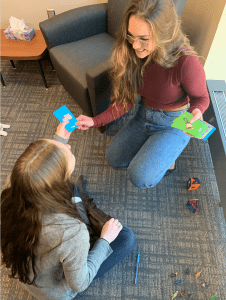 In our previous post we discussed the escape function of behavior. We also reviewed what it may look like when your child is trying to avoid or get out of a task they have been asked to do. One way to handle these behaviors is to change what you do before the behaviors even start. If you set the tasks up in a certain way your child may be less likely to get upset about the work. Here are some examples of how you can do that.
In our previous post we discussed the escape function of behavior. We also reviewed what it may look like when your child is trying to avoid or get out of a task they have been asked to do. One way to handle these behaviors is to change what you do before the behaviors even start. If you set the tasks up in a certain way your child may be less likely to get upset about the work. Here are some examples of how you can do that.
One way to prevent escape-maintained behaviors is to give your child choices. Choices can be delivered in a variety of ways. For example, if your child working on homework, let them choose which pencil they will use, or which chair they will sit in while you work. You can even ask them which task they want to do first, for example “should we start with reading or math tonight?”. Finally, they can choose what they want to work for, like having some TV after their homework or getting to play outside for a while.
Giving them these choices will help them feel involved in the selection of activity and can prevent problem behavior. Choices also allow for the child to feel in control of what they are doing without you completely giving in to what your child wants. Although they are choosing where they sit or what they start with, you will still be able to have them accomplish what you wanted them to.
Another way to prevent avoidance behaviors to be clear and concise with the task you are asking your child. Instead of saying “can you clean up your room” say “please clean up the toys in your room.” This will make it easy for them to understand what they will need to do and keep them from being overwhelmed by too big of a task. These should be framed as a directive, so they know it’s not a choice, but something they need to be doing. If they do have a choice of what they are going to do make sure they know they have to pick. For example, “we need to clean something today, you have to do either the bathroom or your bedroom. “This still incorporated choice, but also lets them know they have to complete one of the tasks.
Here at the Husky ABA clinic we aim to use preventative strategies to keep behaviors from happening, but we also know that they do occur sometimes. This is why next week we will be talking about how to respond when these behaviors do happen.
 Last post we introduced you to the functions of behavior, which are escape, attention, tangible, and sensory. We will start describing these functions in more depth, starting with escape.
Last post we introduced you to the functions of behavior, which are escape, attention, tangible, and sensory. We will start describing these functions in more depth, starting with escape.
If a child always starts throwing his homework around when you give him his math assignments to get out of doing his work, this may be an escape-maintained behavior. Children know that if they act in a certain way, such as throwing a fit or leaving the homework area, they will be able to get out of the task. The child will continue to throw a fit or leave for as long as it works to escape or avoid the unpleasant task. If this is the reason for the problem behavior, changing the dynamic in place will help fix this problem.
Another example of this may be a child trying to avoid a chore at home. If you want your child to clean up their toys and fall to the floor and start screaming until you pick up the toys for them you may be dealing with escape maintained behavior.
Children often use escape if the task they need to be doing is too long, boring/easy, difficult, or nonpreferred. The purpose of these behaviors is to get out of, or escape, unwanted activities. These behaviors can also be used to avoid the activity before it starts. Some children may also try to avoid certain people, like a specific teacher or family members if that person disciplines them or gives them work to do. A final reason a child may escape is that the environment is overwhelming to them. It may be too loud or too bright for some children.
Stay tuned to find out more about escape-maintained behavior and the other functions. Our next post will be on preventative strategies for escape-maintained behavior.
 Last semester, we discussed what it means to be a BCBA, how to use embedded teaching, and how clinicians at the Husky Applied Behavior Analysis Clinic work with your children. Over the course of this semester, we will discuss how the function of behavior impacts our reactions.
Last semester, we discussed what it means to be a BCBA, how to use embedded teaching, and how clinicians at the Husky Applied Behavior Analysis Clinic work with your children. Over the course of this semester, we will discuss how the function of behavior impacts our reactions.
When children appropriately or inappropriately behavior, you may ask yourself… “Why is she biting?,” “why won’t he do his math assignments?” or “I don’t understand why he likes to rock in his chair.” In applied behavior analysis, BCBAs take a highly individualized to identify the “Why?” or the function of the behavior. Through detailed behavioral assessments, BCBAs (and clinicians at the Husky ABA clinic) can identify if these disruptive behaviors occur to one of four reasons. The child may engage in challenging behavior to get out of unpleasant tasks, activities, or situations; gain a reaction (attention) from adults, peers, or siblings; get items, activities, or snacks (tangible); or to meet a sensory need (sensory).
When we identify the WHY (or function of a disruptive behavior), BCBAs will conduct assessments that may consist of interviewing the parent, teacher, or other important individuals’ in the child’s life, observing the child in the environment in which the behavior is likely to occur, and directly testing specific situations to see if unwanted behaviors occur. Together, this information helps BCBAs learn WHY (or the function) of the behavior, and identify indivualized behavioral therapy to decrease disruptive behavior, but more importantly increase behaviors that are socially appropriate (like communication). Over the next few weeks, Husky ABA Clinicians will be reviewing each function of the disruptive behavior (escape, attention, tangible, and sensory), describe strategies that are evidence-based to prevent these behavior, and outline how to respond to this disruptive behaviors if they occur.

The Autism Recovery Foundation logo, courtesy of the Autism Recovery Foundation.
The Autism Recovery Foundation (ARF) is committed to building the workforce in Minnesota for individuals who wish to or are providing ABA services to children diagnosed with autism. They support students who are pursuing their Board Certified Behavior Analyst (BCBA) and Board Certified Assistant Behavior Analyst (BCaBA) credentials. Students pursuing BCBA or BCaBA course work and will be joining or are currently in the Minnesota workforce as an intern or employee are eligible for $500 to $1,500 scholarships. Since 2014, ARF has dispersed more than $75,000 in scholarships to help build a robust, highly qualified workforce dedicated to supported individuals and families with Autism diagnoses.
Congratulations to McKenzie Loch and Maria Ranallo for their BCaBA scholarships! Additional congratulations to Kelly Berth, Jennifer Hagen, Kelsey Loeffler, and Emlie Olson for their BCBA scholarships! More on the Autism Recovery Foundation and the Spring 2020 scholarship awards can be found at: https://www.autismrecoveryfoundation.org/news/spring-2020-bcba-bcaba-scholarships-announced
The organization disperses scholarships to students twice a year, the 2020 deadlines for scholarships can be found on the ARF website. Applications can be found at: http://www.autismrecoveryfoundation.org/services/aba-application
 Over the last dew days you have learned about creating opportunities to teach, waiting for the correct response, and giving prompts if you child isn’t picking up on the sublet hints. In our final blog series of embedded teaching, we aim to teach you on how to use positive consequences or natural actions to encourage appropriate behavior. Often, we call this positive reinforcement. We don’t always have to use extrinsic or outside rewards like candy, screen time, or tokens. Instead, we can more natural reinforcers to encourage your children to appropriately communicate.
Over the last dew days you have learned about creating opportunities to teach, waiting for the correct response, and giving prompts if you child isn’t picking up on the sublet hints. In our final blog series of embedded teaching, we aim to teach you on how to use positive consequences or natural actions to encourage appropriate behavior. Often, we call this positive reinforcement. We don’t always have to use extrinsic or outside rewards like candy, screen time, or tokens. Instead, we can more natural reinforcers to encourage your children to appropriately communicate.
For example, maybe, you are trying to teach your child to use “please” when they ask for items they want. First, you create and wait, by pointing to a toy that is out of your child’s reach. You count in your head for at least 3 seconds, and then you remind or prompt your child what they need to do. This can be accomplished by saying “Remember to say please when you ask your mom or dad for toys.” Once your child states, “Can I have the toy, please?” Immediately acknowledge this communication and reinforce this by giving the child the toy quickly. Always try to associate this this natural, positive consequence with your affirmation, encouragement, and acknowledgement. Natural reinforcers may include verbal praise, such as, “Wow! I’m so proud you are using manners!” Always try to very specific when giving acknowledgement to your child. This allows your child to learn what they did correctly and be motivated to repeat the behavior again.
Some children may struggle communicating vocally, and that’s okay. We can still use embedded teaching for them to learn appropriate ways to meet their needs. If your child is nonverbal (that is, does not talk to communicate his/her needs), we may want to teach them to point to items they may need. If a toy is out of reach, you would still create and wait and prompt(remind) the child to point to what they need. Once your child points or you help them point to what they want, you can reinforce their nonverbal communication with giving them the toy. Remember to always tell your child what they did correctly “Nice pointing to what you needed!” to encourage them to continue to point to items.
Embedded teaching (or sometimes called naturalistic or incidental teaching) is an excellent technique that our faculty and graduate clinicians use all the time at the Husky ABA clinic. We capitalize on learning opportunities in real-world contexts to teach your child to communicate appropriately. Embedded teaching is a fantastic way to teach new behaviors in your everyday life!
Check out our Facebook page for a demonstration of these techniques!
Like us on FaceBook!
 In our last post, we outlined about the “create and wait” technique of embedded teaching. This is when you create a situation that would require a specific response from your child and wait for them to engage in the correct behavior. What happens if your child does not respond (stares at you blankly) or responds incorrectly? It may be necessary to remind, model, or prompt your child what they need to do! For example, you may give hints to your child about what you are expecting them to do.
In our last post, we outlined about the “create and wait” technique of embedded teaching. This is when you create a situation that would require a specific response from your child and wait for them to engage in the correct behavior. What happens if your child does not respond (stares at you blankly) or responds incorrectly? It may be necessary to remind, model, or prompt your child what they need to do! For example, you may give hints to your child about what you are expecting them to do.
For example, when you are the grocery store, you allow your child to pick a snack they like for the week. Perhaps, the goldfish are on the top shelf and they cannot reach it. Rather then grabbing the item, create and wait.Count to three in your head to see if they will ask for your help. If they don’t ask, try to prompt or give hints to what your child needs to do to get the gold fish. First, you point at the goldfish. Second, you may say, “What do we say when we need help from mom or dad?” Finally, you may prompt or remind your child to say, “Say ‘I need help, please.”
By prompting or reminding,this gives your child to understand and figure out what you want them to do. Often, you may notice your child needs lots of prompts.Over time, you will start to notice the number of hints, reminders, or prompts will decrease. You will notice your child is communicating more and relying less on your prompts. Remember with embedded teaching, the goal is to encourage more communication. At the Husky ABA clinic, graduate and faculty clinicians want to promote language by embedding earning opportunities at any given moment.
Check out our Facebook page for a demonstration of these techniques!
Like us on FaceBook!
 Teaching your child new skills can be difficult. One way to teach your child new skills, without them even realizing it, is through embedded teaching (sometimes called naturalistic teaching or incidental teaching). The first step in embedded teaching is “create and wait.” This is when you create opportunities for your child to practice a skill (like asking for something they need) and wait for your child to do what is needed.
Teaching your child new skills can be difficult. One way to teach your child new skills, without them even realizing it, is through embedded teaching (sometimes called naturalistic teaching or incidental teaching). The first step in embedded teaching is “create and wait.” This is when you create opportunities for your child to practice a skill (like asking for something they need) and wait for your child to do what is needed.
Embedded teaching can be done anywhere! Often embedded teaching is a fantastic way for your child to learn to request for their wants and needs. For example, your child may be at the table during breakfast with a dry bowl of cereal. This would be a terrific opportunity to for your child to request for some milk! Instead of just pouring the milk, wait for your child to ask for it! When you notice your child may need something (like milk or spoon), create and wait by counting in your head to three. This allows your child time to notice what they need. Those three seconds allows them some time to identify what is missing.
Clinicians at the Husky ABA clinic use embedded teaching every time we work with your child, and we hope to teach you, as a parent, to create these small, meaningful opportunities for your child to practice communicating, requesting, and using manners in your home, at the park, or at the store!
Check out our Facebook page for a demonstration of these techniques!
Like us on FaceBook!
 Meet Samantha!
Meet Samantha!
Samantha is in her second year here at St. Cloud State. She comes from Minnesota State University Moorhead, but ended up finishing her bachelor’s degree at SCSU. She received a degree in Community Psychology with a minor in Communication studies in 2018 and was accepted into the ABA program right after. Her parents are also alumni of SCSU, and she has been coming to campus since she was young and started off her experience at the college in the Lindgren child center. While she didn’t originally decide to come to SCSU she is happy she’s here and loves learning from the professors who are all very knowledgeable in their subjects.
Samantha previously worked with high functioning preschool-aged children in a day treatment environment that was designed to emulate a classroom. She currently works in a level four special education classroom in a general education middle school. The students are lower functioning and engage in high rates of physical aggression, verbal aggression, elopement, and property destruction. While she enjoys working with children of all ages, she thinks found her niche in middle school.
Something interesting about Sam is that she had a heart attack during her first year of college and acquired two neurological disorders. The primary symptoms include sudden loss of consciousness, vertigo, migraines, and chronic fatigue. To aide in her disability, she received a medical alert and mobility assist dog from the local organization, Can Do Canines (they are located in New Hope, MN). Her dog Obie helped her regain her independence and ensured that she could safely attend classes on campus again. After five years as a team, Obie is now retired and spends his days sleeping in the sun next to Luna, his kitty best friend. Obie and Samantha are now featured on a vehicle that was donated to Can Do Canines by Subaru.
 Although behavior analysts can help anyone with behavioral challenges, we often work with children and adults diagnosed with autism spectrum disorder (ASD). Interventions based on ABA can be very beneficial to people diagnosed with autism. Not only is it backed by decades of research, it has become widespread in popular culture.
Although behavior analysts can help anyone with behavioral challenges, we often work with children and adults diagnosed with autism spectrum disorder (ASD). Interventions based on ABA can be very beneficial to people diagnosed with autism. Not only is it backed by decades of research, it has become widespread in popular culture.
Children and adults diagnosed with ASD are very intelligent. Often, they may have a hard time communicating their feelings to others and why they may behave in a way that is confusing. Since BCBAs based their interventions on what actions a client does, a child or adult who cannot communicate is not something BCBAs worry about. Instead, we outline actions we want to see the client do more, and we measure how well our interventions work on increasing the appropriate behavior.
Interventions in ABA are effective for those diagnosed with ASD because we know each person is a unique individual. No two children are the same. Clinicians in ABA prioritize getting to know the child and make their treatments fit their needs. We recognize that those diagnosed with ASD may engage in actions that are confusing to teachers, parents, community members, and siblings. This can lead to frustration, and we, clinicians from the Husky ABA clinic, want to help!
At the Husky ABA clinic, we are experts in producing meaningful behavior change. This may create an individualized plan to teaching a child to independently toilet. Or teaching a child to recognize their frustration and ask for help! In addition, we work with families, teachers, and other important people in the child’s life to create positive environments.
Like us on Facebook!
 Meet Kelsey!
Meet Kelsey!
She is another second-year student at St. Cloud State in the ABA program. Kelsey received her undergraduate Psychology degree at the University of Wisconsin- River Falls. She has also worked at a center for children diagnosed with Autism Spectrum Disorder (ASD) for three years. While working at this clinic she started to show an interest in the field of ABA. She is currently doing in-home therapy for children diagnosed with ASD while working towards her master’s degree.
Kelsey chose to come to St. Cloud State because her coworkers encouraged her to check out the master’s program. She says that she thought the program would be easier than it is, but she could not be happier at SCSU and is also learning so much more than she ever imagined. All the professors want students from the ABA program to come out of it with as much knowledge and experience as possible, and because of this, all the classwork can be challenging at times, which is why Kelsey says one of her biggest accomplishments so far has been making it through the first year of the program.
A not-so-fun fact about Kelsey is that her laptop crashed during finals her first semester in the program, so now she prints all her work or has it on one of many flash drives, so she never loses it again. She also prints out every article from class (which can be up to 10 a week) and loves to use highlighters to pick out the most important information.
Like us on FaceBook!
 In our previous post we discussed the escape function of behavior. We also reviewed what it may look like when your child is trying to avoid or get out of a task they have been asked to do. One way to handle these behaviors is to change what you do before the behaviors even start. If you set the tasks up in a certain way your child may be less likely to get upset about the work. Here are some examples of how you can do that.
In our previous post we discussed the escape function of behavior. We also reviewed what it may look like when your child is trying to avoid or get out of a task they have been asked to do. One way to handle these behaviors is to change what you do before the behaviors even start. If you set the tasks up in a certain way your child may be less likely to get upset about the work. Here are some examples of how you can do that.








